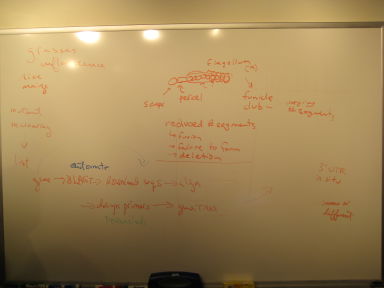Difference between revisions of "Needs Analysis Workshop/Report-out Day1"
From phenoscape
| (3 intermediate revisions by one other user not shown) | |||
| Line 1: | Line 1: | ||
| − | === | + | ===Evo Group report-out=== |
| − | * | + | * need to improve ontologies, e.g. for describing behavior |
| − | * | + | * need to improve tools for analyzing images |
| − | + | * covariance of entities, attributes | |
| − | + | * broader queries of entities within particular constraints, such as structures | |
| − | + | * need capacity to store media (e.g., images, movies) | |
| − | * | + | * need environmental, ecological, and geographical data |
| − | * | ||
| − | * | ||
| − | |||
| − | |||
| − | |||
| − | |||
| − | |||
| − | |||
| − | |||
| − | |||
| − | === | + | ===Devo Group report-out=== |
| − | * | + | * identifying homologies among distantly related taxa |
| − | ** | + | ** for example, do fishes have digits? E.g., if genes have similar effects on fins as on digit development. |
| − | ** | + | * patterns of covariation |
| − | ** | + | ** for example, cusps on mammalian teeth |
| − | ** | + | ** could be used to identify "character modules" that are well-connected |
| − | * | + | ** connections within modules should be more stable than between |
| − | + | * for a branch hypothesized to be under positive selection (from e.g. a molecular analysis), identify candidate phenotypes that could have been selected for | |
| − | ** | + | ** map synapomorphies onto a phylogeny |
| − | * | + | ** identify phenotypes with highest rate of change on that lineage |
| − | ** | + | ** needs phylogeny that is selectable and manipulable |
| − | * | + | * use the database to point out holes in the knowledge |
| − | === | + | ===Discussion=== |
| + | [[Image:Day2-brainstorming1.whiteboard.JPG|thumb|right|384px|Analysis Pipeline, Character Modules]] | ||
| + | * enrichment analysis: given a list of genes, which phenotype terms are overrepresented among them | ||
| + | * capturing representing variation seems to be a general problem and challenge, but critically needed | ||
| + | ** variation in regulatory (or morphogenic) gene expression and corresponding phenotypic changes (Hox gene expression example) | ||
| + | ** polyphenism: variability of phenotype that can distinguish species but is also dependent on environmental factors or variable levels of gene expression | ||
| + | ** do we need to capture frequencies for polymorphisms to represent variability | ||
| + | ** there are morphological differences even between inbred strains, for example for JAX mouse strains in cranial morphology | ||
| + | * integrating with genomic resources: | ||
| + | ** linking out to genome databases seems mandatory | ||
| + | * alerting features | ||
| + | ** for example, saving queries as RSS feeds | ||
| − | + | [[Category:Needs Analysis Workshop]] | |
| − | |||
| − | |||
| − | |||
| − | |||
| − | |||
| − | |||
| − | |||
| − | |||
Latest revision as of 20:04, 18 January 2008
Evo Group report-out
- need to improve ontologies, e.g. for describing behavior
- need to improve tools for analyzing images
- covariance of entities, attributes
- broader queries of entities within particular constraints, such as structures
- need capacity to store media (e.g., images, movies)
- need environmental, ecological, and geographical data
Devo Group report-out
- identifying homologies among distantly related taxa
- for example, do fishes have digits? E.g., if genes have similar effects on fins as on digit development.
- patterns of covariation
- for example, cusps on mammalian teeth
- could be used to identify "character modules" that are well-connected
- connections within modules should be more stable than between
- for a branch hypothesized to be under positive selection (from e.g. a molecular analysis), identify candidate phenotypes that could have been selected for
- map synapomorphies onto a phylogeny
- identify phenotypes with highest rate of change on that lineage
- needs phylogeny that is selectable and manipulable
- use the database to point out holes in the knowledge
Discussion
- enrichment analysis: given a list of genes, which phenotype terms are overrepresented among them
- capturing representing variation seems to be a general problem and challenge, but critically needed
- variation in regulatory (or morphogenic) gene expression and corresponding phenotypic changes (Hox gene expression example)
- polyphenism: variability of phenotype that can distinguish species but is also dependent on environmental factors or variable levels of gene expression
- do we need to capture frequencies for polymorphisms to represent variability
- there are morphological differences even between inbred strains, for example for JAX mouse strains in cranial morphology
- integrating with genomic resources:
- linking out to genome databases seems mandatory
- alerting features
- for example, saving queries as RSS feeds
